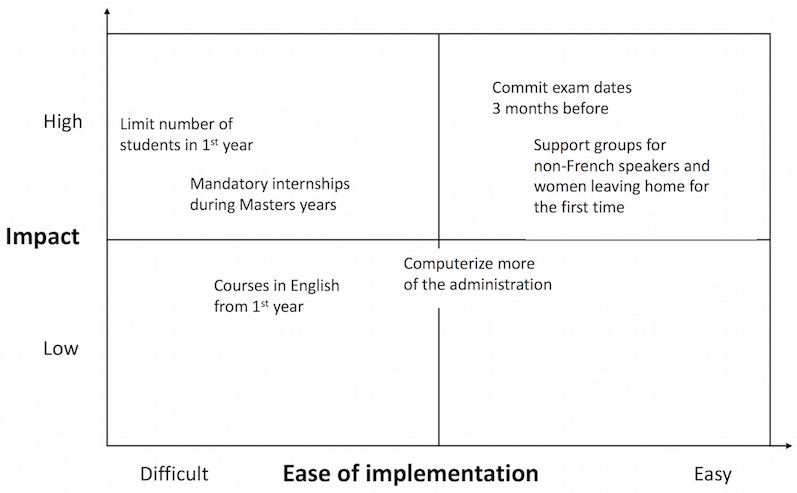Suggested method for choosing your strategy from a list of proposals
Once you have a set of insights about customers, competitors, your industry, the external environment and you ability to implement, the next step is to decide what you are going to do about it. Ideally, the choices will be a collective proposal from the entire team that did the situation analysis. There is a human-nature challenge in reaching a consensus in that people tend to believe their own area is complex and difficult and that everyone else’s area of work is simple. Let me illustrate with an example.
We tend to under-rate other people’s work
Shortly after I became the European software operations manager for Digital Equipment Corporation, we held a workshop with the manufacturing team, based in Galway, Ireland. Manufacturing reported elsewhere in the matrix. The enlightened workshop facilitator had each team separately draw a diagram of their own and the other team’s workflows. The results were equal and opposite diagrams. Each team showed their own work area as a complex flow chart with many inputs, outputs and transformations. Each showed the other team’s work as a single box, either ‘Make it’ or ‘Sell it’. Over dinner that evening, the manufacturing site manager asked me why the European business leadership in Geneva was necessary, since they (we) only seemed to prevent him going directly to market.
How to prioritize your choices
The best single method I have found for prioritizing strategic choices has two steps. The first is to vote and the second is an Ease / Impact diagram. A simple voting method starts when everyone present agrees that the definitions of the strategic choices are clear. Each person then gets three votes to allocate as they see fit. They can give all three to a single suggestion or split their votes. If there is a tie after three votes, give each person a further two votes. The result should be a draft list of five initiatives. Use an Ease / Impact diagram to validate the list. The diagram below comes from a strategy session after a survey of business school students.

If all your potential strategic choices are in the low-impact high-difficulty box, you need to start again. If you want a more sophisticated prioritization tool than an Ease / Impact diagram, consider a criteria rating table. This takes some planning. You should agree the decision criteria before knowing what the list of insights is. It is too easy for people to reverse-engineer the criteria if they have a personal preference for which items are the top priorities. The table below came from an evaluation of six different software solutions for automatically analyzing verbatim answers to surveys, compared to human analysis. The decision criteria are along the top, and each had a definition that was agreed at the start of the study, before any software had been evaluated.

Articulate your strategy
Since you understand your current situation in all important dimensions and have decided on the top priorities, now is a good time to articulate your strategy concisely. Customer experience strategy is a subset of a corporation’s overall strategy and should be positioned as such. For example, if your company explicitly has no plans to grow its business, the customer experience strategy should not be positioned as enabling growth. Here is an example of a strategy statement, with associated initiatives:
- Our vision: customers for life.
- Our strategy: achieve industry-leading customer loyalty and renewal rates by ensuring every customer achieves the ROI they expect from our services.
- Strategic initiatives:
- Implement Customer Success teams for our largest customers, dedicated to helping them achieve expected benefits.
- Implement online and social-media user groups to involve the most passionate users and develop a sense of community.
- Regular proactive outreach to all customers who do not contact us themselves and are not in the user groups. Ensure no customer is forgotten.
- Catch up with our competitors in the area of free online training and how-to videos.
- Catch up with our competitors in number of languages in our service centers, moving from the current two languages to eight, within two years.
The overall strategy statement shows a clear focus on existing customers. By implication, no new work will be done on using references to attract new customers, or on fixing defective products, for example. Outside the five initiatives, all existing improvement work is considered to be at least adequate. The five investment proposals may of course include moving people from an existing work area to do the new work.
Prepare for the investment decisions
If one or more of your top five priorities require no new investment in people or other resources, you are in luck, though that seems unlikely to happen. Preparing for the investment decisions requires hard work and good timing. For many companies, perfect timing means that the strategy development exercise is well-coordinated with the annual budget cycle. ‘Well-coordinated’ means the situation analysis and initiative proposals should be complete before the budget cycle starts, ideally several weeks before, to minimize surprises and maximize the opportunity to socialize the work.
Securing the investments involves understanding the level of sponsorship you have for your work, and how you will need to communicate it to each individual you are dependent upon for funding. These are topics for another day and another blog post.
(As is often the case, this blog post is a mildly-edited version of a chapter in one of our books. In this case the book is Customer Experience Strategy – Design and Implementation. All of our books are available in Kindle and print versions from Amazon.)



